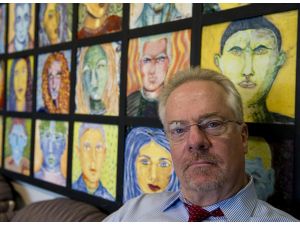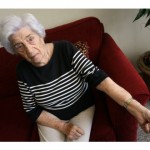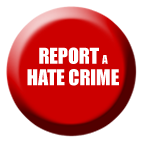By DAVID WHITING, COLUMNIST
THE ORANGE COUNTY REGISTER
October 18, 2012
Tattoos tell stories, whether on the arm of a Holocaust survivor or a white supremacist.
The faded black number on Ester Bershtel’s left arm testifies to one woman’s strength to escape the horrors of Auschwitz.
The number “14” on Wade Michael Page’s left shoulder testifies to a national resurgence in white supremacy, a movement with deep roots in Orange County – a county where Page once lived.
Page is the man who committed suicide in August after killing six Sikhs in a Wisconsin temple, an incident which raises troubling questions that require answers.

The Orange County Human Relations Commission that Rusty Kennedy heads offers an anti-bullying and violence prevention program called BRIDGES to help students combat hate. It lists 20 active middle and high schools in Orange County.
SAM GANGWER, THE ORANGE COUNTY REGISTER
Bershtel, a 91-year-old Laguna Hills resident, knows better than to pretend that white supremacy will simply disappear. She lost most of her family in the Holocaust.
Fortunately, there are things we can do to combat the rise in racism.
• • •
One thing to remember is that if ignored, history often repeats itself.
On Sept. 15, 1994 at 7:35 p.m. shots rang out on the 20300-block of Beach Boulevard in Huntington Beach. Outside a fast-food restaurant, Vernon Flournoy, 44, an African American refrigeration technician, lay dying of his wounds.
Two local skinheads were arrested. Jonathan Russell Kinsey, 19, pleaded guilty to murder and a hate crime. Robert Dylan Wofford, 17, was found guilty of second-degree murder and a hate crime.
Two months ago on Aug. 28 – less than three miles from where Flournoy was killed – an African American skate boarder reportedly agreed to go one-on-one against a skinhead skater.
Nine skinheads beat the black skater, according to Rusty Kennedy, executive director of OC Human Relations. One skinhead, a female, stabbed the skater.
The black skater survived.
Kennedy has been monitoring hate since he was a kid growing up in Fullerton. “In the ’50s and ’60s, blacks weren’t welcome here,” Kennedy recalls. “There were restrictions on selling to Chinese.”
Kennedy remembers when realtors contested the Rumford Fair Housing Act., outlawing discrimination. In 1964, California voters passed Proposition 14, reversing the act. Two years later, the state Supreme Court declared the proposition unconstitutional.
Today, Kennedy says tolerance “starts in the home.”
• • •
Kennedy echoes other experts saying, “You need to deal with your own attitudes, of course, and then you need to talk to your children.”
He says next steps include ensuring that schools and religious institutions offer diverse experiences.
“On Sunday morning,” Kennedy reminds, “we’re more segregated than at any other time. Through faith and tolerance, we can be looking out for other people.”
As for educational institutions, Kennedy says, “At schools, kids come into contact with others who are different. Use these opportunities for positive experiences. See that your school takes action to build awareness.”
The O.C. commission that Kennedy heads offers a program called “Bridges” to help students combat hate. Currently, it lists 20 active middle and high schools in Orange County.
“Their worlds grow larger,” the program states, “as they are exposed to different people, backgrounds, cultures and experiences.”
• • •
Melissa Carr is regional director for the Anti-Defamation League, a leading civil rights organization, and is based in Orange County.
She gave up working as a corporate lawyer to devote herself to being a watchdog for hate groups.
Carr and other hate experts say information is one of the best ways to combat racism.
Carr warns, “One of the concerns is that these (white supremacy) groups have a desire to recruit. As a parent, there’s concern kids could get caught up in the movement.”
In Orange County despite – or because of our increasingly diverse population – that’s especially true.
The ADL warns, “alienated white youth have found a welcome reception on the Internet from white supremacists hungry for new recruits.
“The Internet has made it very easy for young people to be exposed to the online message forums and social networking websites prevalent in the racist skinhead subculture.”
The ADL adds, “Most importantly, (the Internet) gave new life to the white power music industry, around which much of the racist skinhead subculture revolves.”
The message is that parents should be aware of their children’s online habits. But cracking down on hate is a delicate issue with a long and complicated history.
Arguing for free speech and the Constitution’s First Amendment, the American Civil Liberties Union famously defended a march planned in the mid-1970s in Skokie, Ill, by neo-Nazis.
The ACLU lost followers and funding.
Carr and her colleagues agree we need to tolerate troublesome speech. Consider the “14” on Wade Page’s shoulder. It stands for the 14-word white supremacy slogan: “”We must secure the existence of our people and a future for white children.”
That’s free speech.
So where do we draw the line between free speech and hate crime?
That can be a tough call in an age where some favor clothes with an edge.
• • •
Consider the German Iron Cross. As a kid, I wore one around my neck as a surfer’s cross. Groovy, right?
My Dad, who served in World War II, didn’t think so. Bye-bye surfer’s cross.
Motorcycle clubs also adopted the Iron Cross. Today, clothing companies such as Affliction sell T-shirts featuring the symbol.
In the exact spot where the Iron Cross is emblazoned on an Affliction shirt, it also is tattooed on the chest of the former leader of one of Orange County’s largest and most violent white racist criminal gangs.
Carr is careful to note that clothing may mean nothing because hate symbols have been co-opted. Still, she asks people to be aware of hurtful designs such as Nazi death skulls.
California law states that hate crimes are criminal acts committed because of sexual orientation, disability, gender, religion, ethnicity or race.
The law makes it clear that free speech doesn’t include burning crosses on someone’s lawn, painting swastikas on private property, making criminal threats or resorting to violence.
As such, the swastika painted in August on the home of a black family in Ladera Ranch constitutes a hate crime.
• • •
Still, even as the number of white racist groups climbs, experts see hope.
Mark Potok, a senior fellow at Southern Poverty Law Center, a leading hate monitoring organization, explains, “We’re going through a very bad time right now, but this too shall pass.
“People are reacting to real changes that are happening in our society. When you look at history, virtually every major social advance was followed by a social backlash.”
That backlash can end with a renewed commitment to tolerance. It’s too late for Vernon Flournoy, killed by the Huntington Beach skinhead. And it’s too late for the Sikhs killed by Page.
But it’s not too late for the Ladera Ranch family who woke up to a swastika.
- Ester Bershtel shows her number, A-15959, tattooed on her arm while at Auschwitz, the concentration camp in Poland where 1.1 million people were killed. ANA P. GUTIERREZ, FOR THE ORANGE COUNTY REGISTER
- White advocate clothing such as these T-shirts can be found in stores. KATE LUCAS, ORANGE COUNTY REGISER
- Rusty Kennedy is the Executive Director of The Orange County Human Relations Commission, although he has been monitoring hate since he was a kid growing up in Fullerton. “In the ’50s and ’60s, blacks weren’t welcome here,” Kennedy recalls. “There were restrictions on selling to Chinese.” SAM GANGWER, THE ORANGE COUNTY REGISTER
- The Orange County Human Relations Commission that Rusty Kennedy heads offers an anti-bullying and violence prevention program called BRIDGES to help students combat hate. It lists 20 active middle and high schools in Orange County. SAM GANGWER, THE ORANGE COUNTY REGISTER
This is the sixth of a six part series by David Whiting:
Oct 13: In the wake of a former Orange County man killing Sikhs in Wisconsin, documents and interviews detail a dangerous landscape in O.C. of racism, violence and crime.
Oct 14: An uncover agent reveals the secret world of white racist criminal gangs.
Oct 15: An Orange County man many regard as the nation’s leading Aryan philosopher explains the movement.
Oct 16: Inside the world of the former leaderof one of Orange County’s largest and most violent gangs.
Oct 17: Why the former Irvine high school student took over a gang, how he found redemption.
Oct 18: Battling hate, changing culture.





